Diffusing essential oils has many benefits for humans but what effect do they have on your pets?
Worryingly, some essential oils (such as tea tree) are not safe for cats.
A number of essential oils are toxic to cats and exposure can cause respiratory problems, liver failure and other health issues.
Not all essential oils are harmful though, this guide will help you separate the safe essential oils from the dangerous ones so you can continue enjoying aromatherapy without harming your pets.
Below are 7 essential oils that are safe to use around cats:
Contents
1. Cedarwood
Cedarwood does not usually contain phenol and is considered safe to use around cats.
As with all essential oils, it is important to make sure the one you have doesn’t contain any added chemicals.
Cedarwood is commonly used as it stimulates blood circulation, reduces pain and supports skin health. Make sure you use a low concentration of cedarwood oil.
2. Lemongrass
This is usually a hydrosol (water-based) and is safe to use around cats at a low concentration. However, lemongrass oil should not be applied directly to a cat’s skin or ingested.
This means you can diffuse lemongrass oil in your home safely but make sure your cat never comes into direct contact with the oil.
If using lemongrass, only do so occasionally. Some people say lemongrass is effective for getting rid of fleas.
3. Rosemary
Rosemary oil is safe if it is diluted and diffused properly.
Rosemary is often used as a natural flea treatment.
4. Frankincense
Another popular essential oil that is safe for cats is Frankincense.
This essential oil acts as a disinfectant, antiseptic and anti-inflammatory.
It also helps with digestive issues and has a positive effect on arthritic pain and wound healing.
5. Chamomile
Chamomile is considered safe to use around cats.
It is a common essential oil for treating skin problems, easing stomach problems and encouraging sleep.
6. Marjoram
Marjoram is often used by pet owners as it helps to relieves anxiety, stress and hyperactivity in cats.
7. Valerian
Valerian root based oils are often used by pet owners to help reduce anxiety, encourage relaxation and promote wound healing.
Always make sure you dilute your essential oils with a safe carrier oil such as castor oil, olive oil or coconut oil.
How To Use Essential Oils Around Cats
While not all scents are harmful to cats they can be if you use them incorrectly.
It is extremely important to use essential oils carefully.
- First of all, always use the oil in a diluted or diffused form. In order to be safe to diffuse around your cat it needs to be highly diluted (at least 50 drops of carrier oil per 1 drop of essential oil).
- Next, make sure the room you will be using the essential oils in has good ventilation and your cat can come and go from the room as they please. This ensures your cat can leave if they find the scents too strong or feel uncomfortable in the room.
- Finally, only diffuse the essential oils for a short period of time. 20 – 30 minutes is a good guideline. If you have never diffused essential oils around your cat before, do it for less time and watch them closely for signs of distress, discomfort and toxic exposure.
Diffusion Is The Safest Way To Use Essential Oils
Any essential oil can be dangerous if it is used incorrectly or in excess.
The best way to use essential oil in a home with cats is diffusion.

The essential oil should never be directly applied to your cat’s skin.
When using a diffuser the essential oil is diluted, the room needs to be ventilated and your cat should be able to leave if they want to.
Always keep a close eye on your cat and take all precautions to prevent toxicity.
Only diffuse one essential oil at a time to minimise risk.
Tips For Using Essential Oils Safely Around Pets
- Keep all essential oils stored out of reach of your cat
- Always wash your hands thoroughly after handling essential oils
- Never clean with essential oils
- Use highly diluted essential oils to help minimise risk
- Always use diffusers rather than concentrates
- Use your essential oil diffuser in a room your cat does not go in
- Avoid low quality or synthetic oils
Why Are Some Essential Oils Harmful For Cats?
Essential oil is a natural compound that is taken from plants.
The concentrate is often mixed with a carrier oil but many essential oils contain heavily concentrated phenols as well as ketones and monoterpenes.
These are compounds that cat’s bodies are not able to break down.
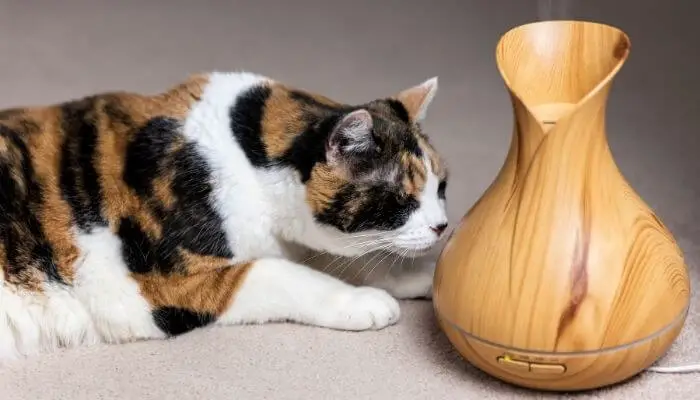
This is because cats are deficient in the enzyme responsible for metabolizing phenols (glucuronyl transferase).
As cats are not able to break down the phenols it means the compound will be stored in the cat’s body leaving them in a state of toxicity.
This is why the essential oils that contain high amounts of these compounds are incredibly dangerous for cats.
Humans and cats are very different so the things that are safe for humans can be life-threatening for your cat.
Always err on the side of caution when it comes to essential oils.
The following essential oils contain high amounts of phenol and are dangerous for cats.
AVOID:
- Tea tree oil
- Citrus oil
- Peppermint oil
- Lavender
- Sandalwood
- European pennyroyal
- Ylang ylang
- Sweet Birch oil
- Pine oil
- Wintergreen
- Eucalyptus
- Oregano
- Dill
- Thyme
- Basil
- Bergamot
- Geranium
- Mountain savory
- Clove
- Cinnamon
While many of these oils are safe to diffuse around cats they are scents that your cat will not like (this is why these essential oils can be used to deter cats from pooping in places they shouldn’t).
Note: We have tried to list all of the common essential oils that are not suitable for use around cats. However, this list is by no means exhaustive.
If you want to use an essential oil that has not been mentioned, please speak to a vet or do further research before using it.

It is important your cat doesn’t inhale, ingest or come into contact with these essential oils.
If you are using any of the oils listed above, make sure you are in a room that your cat cannot enter.
Always wash your hands thoroughly between handling these essential oils and touching your cat.
As cats have thin skin it doesn’t take long for essential oil and its compounds to be absorbed into the bloodstream.
A Note On Toxicity
The type of essential oil being used, the dose/ concentration and the application method will all have an impact on how toxic it is for your cat.
In addition to this, there is very little data on the toxicity of all essential oils.
This is why it is important to only use the essential oils that are known as being safe and only use them in a very careful and specific way.
3 Ways Cats Can Come Into Contact With Esential Oils
- Direct contact – essential oil should never be applied to your cats skin. Your cat could come into contact with the oil from surfaces, from your skin and from the diffuser. If a cat gets essential oil on their skin they are also at risk of ingesting it when they groom themselves.
- Ingestion – as mentioned, a cat may accidentally ingest the oil when they are grooming themselves. Other risks include licking the oil from the diffuser or counter top.
- Inhalation – when diffusing essential oils there are droplets of the diffused oils in the air that your cat may breathe in. Cats with asthma and other medical conditions are more likely to be negatively impacted by this, incense is also very dangerous to cats for this reason.
Signs of Toxic Exposure
- Drooling
- Vomiting
- Watery eyes and/ or nose
- Tremors
- Low blood pressure
- Low heart rate
- Liver failure
- Difficult breathing
- Wobbliness/ difficulty walking
- Seizures or collapse
Your cat may also have sores or inflamed skin where the essential oil has touched them.
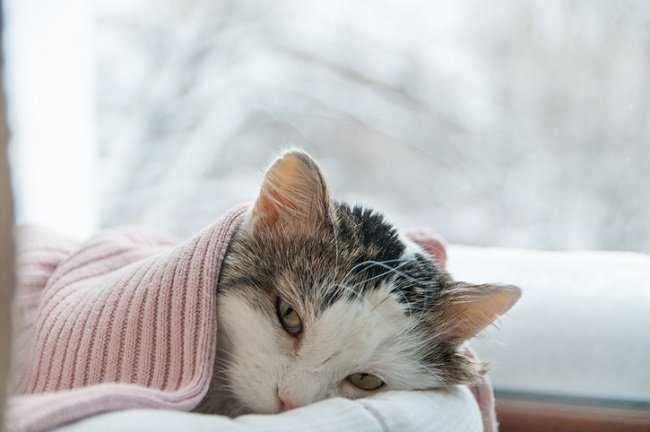
If you notice your cat is having any of these symptoms, contact your vet immediately.
It is worth keeping the essential oil bottle handy as the concentration and ingredients can help a vet decide on the best treatment.
Essential oil poisoning can be serious and tends to affect the liver the most. This is because the liver is where toxins are broken down and removed.
As cats cannot break down the toxins it means they end up being stored in the liver.
This is why the liver tends to be most impacted by essential oils.
To Summarise
Essential oils are popular in many homes and they still have a place in homes with pets.
However, using essential oils should be approached with caution as certain oils are harmful to cats.
There are others that are safe but they need to be used properly to avoid issues. We recommend consulting with your vet before using new essential oils around your cat.
As an Amazon Associate I may earn a small fee from qualifying purchases at no extra cost to you. This helps us run the site, so thanks for your support!

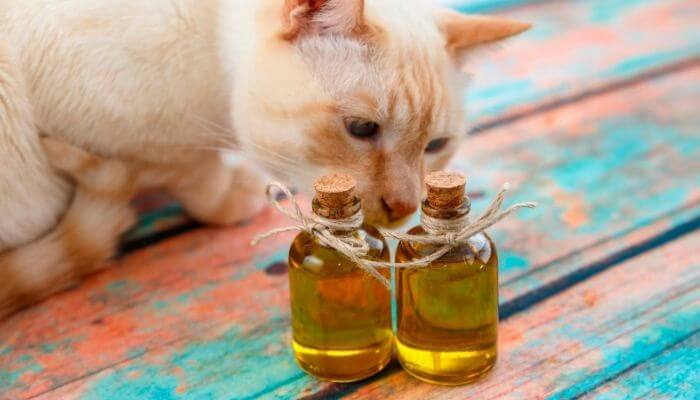







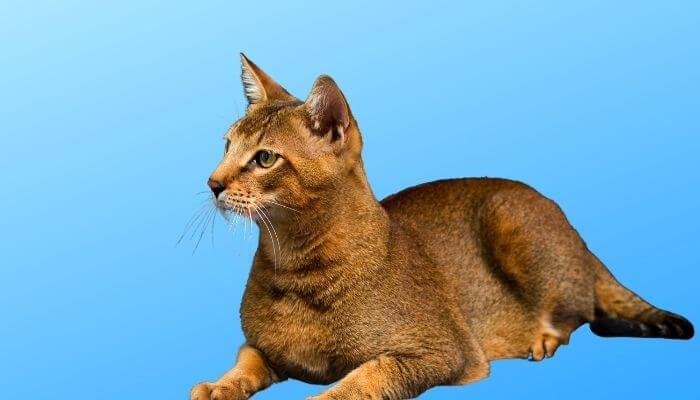


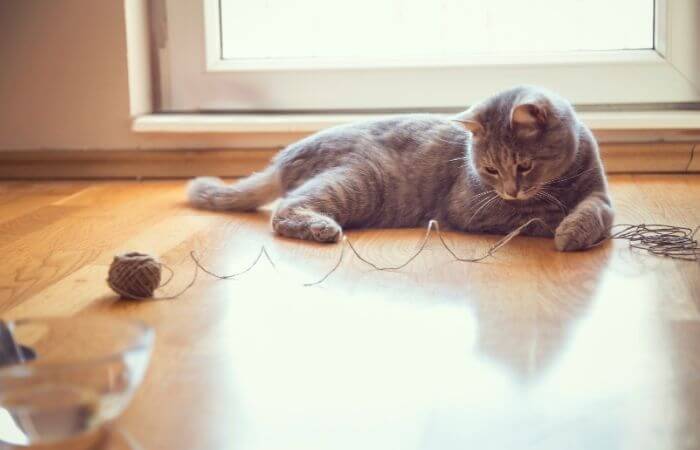
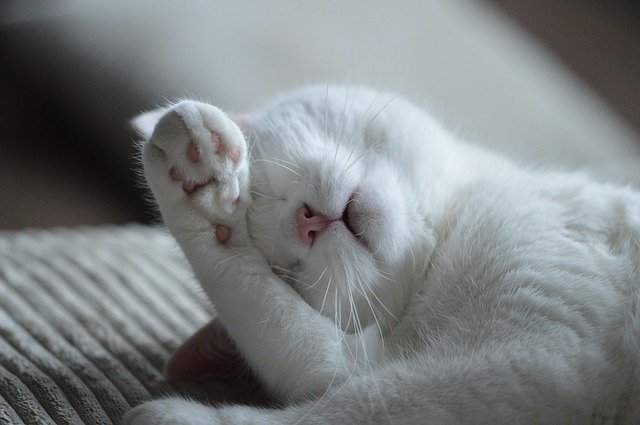

Leave a Comment